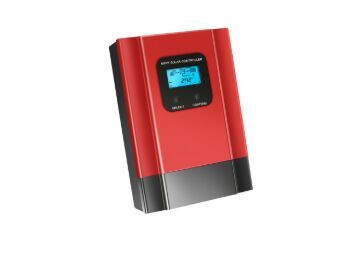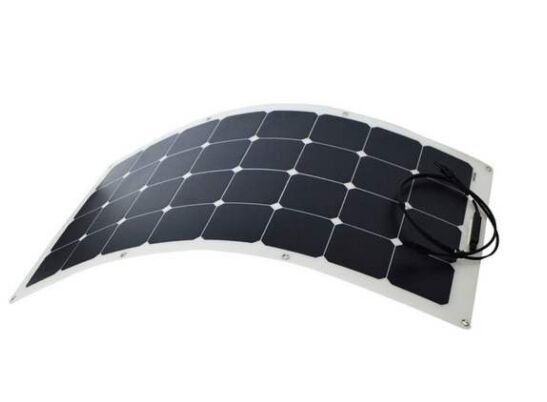The solar system in a solar inverter is composed of a battery board, a charge controller, an inverter, and battery. The inverter is a device for power conversion and is a device that inverts the DC power in the battery into AC power. Inverters can be classified according to excitation methods, mainly self-excited oscillation inverters and other-excited oscillation inverters.
The inverter not only has the function of DC to AC conversion but also can maximize the function of solar cell performance and system fault protection. As an important part of the solar power generation system, the photovoltaic inverter has the main function of converting the DC power generated by the solar panel into 220V or 11V AC power output through the power module for use by the load. The easiest way is to install a string of inverters on the ground. Simple, affordable parts rarely fail. The difficult method is to install power electronic equipment behind the panel on the roof, and (usually) install the inverter on the ground.
The reliability and safety of the inverter directly affect the overall smooth operation of the solar power generation system, and its conversion efficiency affects the power generation efficiency of the solar photovoltaic power generation system. (12V to 220V portable charger power bank)The inverter is a power adjustment device composed of semiconductor devices, which can convert DC power into AC power. It consists of a boost circuit and an inverter bridge circuit. The boost circuit boosts the DC voltage of the solar cell to the DC voltage required for inverter output control; the inverter bridge circuit converts the boosted DC voltage into an AC voltage with a common frequency equivalently. The inverter is mainly composed of switching elements such as transistors. By regularly switching the switching elements on and off repeatedly, the output is changed from direct current to alternating current. Of course, it is not practical to simply generate the inverter output waveform from the on and off loops.
Generally, high-frequency pulse width modulation is required to narrow the voltage width near the ends of the sine wave, the voltage width at the center of the sine wave is widened, and the switching element is always operated in a direction at a certain frequency during a half-cycle, thus forming a pulse wave Column (quasi-sine wave). Then pass the pulse wave through a simple filter to form a sine wave.
Solar inverters are more popular in the world today, including centralized inverters, string inverters, multi-string inverters, and component inverters. Among them, centralized inverters are generally used in large-scale photovoltaic power plant systems, mainly due to the high power of the centralized inverter system and the relatively low cost; the string inverters are already in the current market. The most popular inverter, the string inverter can track the peak value of the maximum power at the DC side, and the technical cost is also reduced a lot; the multi-string inverter can be said to be a centralized inverter and string The advantages of the inverter; the component inverter is mainly to connect each photovoltaic component with an inverter so that the system cooperates better when working.
1 PV (solar panel) input terminal.
2 AC mains input terminal, connected to the AC power supply.
3 AC output terminal, connected to the load.
4 The ground terminals of the inverter input and output must be grounded.
5 AC input can reset the circuit breaker (/fuse). Press it
If it trips due to a short circuit, reset it.
6 AC output can reset the circuit breaker (/fuse). Press it
If it trips due to a short circuit, reset it.
7 AC universal socket to connect the load.
Low-frequency DC to AC solar inverter with MPPT charger TPS series uses TLP250 optocoupler to realize full-bridge drive inverter technology. Four 15KUF/80V high-power electrolytic capacitors can ensure that ripple and internal resistance are minimized. High-quality EMI filter inductor can effectively protect the load equipment from surge and interference.
The EI laminated power transformer is made of brand-new silicon steel and high-quality windings, which ensures high efficiency and strong power generation capacity. This power supply model is based on the TI2000 series 32-bit high-performance DPS processor design.
Depending on the length of use, the solar panel will also have problems, resulting in reduced performance, but unlike a faulty inverter, this usually does not cause the system to shut down completely. Therefore, choosing a reputable manufacturer like SCIENTEK ELECTRICAL to pay extra costs will provide you with long-term warranty service and a strong guarantee for your solar panels. The service life of the general inverter is 10-20 years, and the warranty period of the solar inverter is 5-12 years. Of course, the inverter manufacturer also provides extended warranty services. With a longer warranty period, the inverter is purchased. Consumers will also get more protection.
At the same time, considering that the inverter is usually located in harsh weather conditions (including rain, humidity, and extreme heat), it is possible to use a high-quality inverter and install it in a sheltered location. This will obtain a longer service life.

If you plan to expand your solar system in the future, this is an important consideration.
The best solution at present is to consider using multiple MPPT (Maximum Power Point Tracking) inverters. These solar inverters have multiple MPPT trackers that allow you to add other solar PV arrays or install the array in different directions later. This will allow you to easily add new panel strings (even if the new panel is not the same as the original module) to the current system.
Some solar panels are equipped with a small MPPT inverter at the rear of the module, usually called a microinverter. These potentially allow different types of solar panels to be incorporated into the same solar system, overcoming the shadowing problem and making it possible to monitor individual solar panels. In the United States, these products have a rapid growth trend and have been more widely used in Australia.
Solar inverters are divided into independent solar power inverters and grid-connected solar power inverters in applications. Independent solar power inverters are mainly used in remote areas without household electricity and individual household users. Power generation inverters are mainly used in desert power stations and urban rooftop power generation systems.
The overall role of the solar inverter is to obtain the corresponding sinusoidal AC power through the full-bridge circuit and then use the SPWM processor through various intermediate systems such as modulation, filtering, and boosting, and finally supply it to the end customers who need to use electricity. In fact, solar energy is a system that provides energy, and an inverter is a device that changes the current. The energy in solar energy is obtained by the inverter. The DC battery that can be used is stored in the battery for use. This is the role of the solar inverter. As a result, solar inverters have become the core components of photovoltaic wind power generation systems. However, it is important that the cost of new energy generation is low, and solar inverters must operate at high speeds.(Inverter,Voltage Regulator,Solar Panel,Voltage Stabilizer)
The inverter needs to be able to handle at least the maximum power that the solar system can produce. This usually means that if you want to use a 5kW solar system, you need a 5kW panel and a 5kW solar inverter. The rated values of solar inverters are "DC input" and "AC output". Make sure that your rated power is also suitable for the output of solar panels under DC! The best advice is to install as many solar panels as possible (and install them on the roof), and purchase solar inverters to suit the maximum power of the system. If you choose a string inverter, you must remember to replace it within 8 to 12 years.
The grid-connected inverter has various shapes, sizes, and weights. The smallest string inverter is about the size of a large briefcase. The larger suitcase is about the size of a small suitcase.
They are usually placed as close to the meter as possible and should always be in a cool place for the best performance. The best suggestion is to take a look at the solar inverter (or check its specification sheet) to see if it is suitable for your meter and how it will look after installation.
Some grid-connected inverters are weatherproof, so they can be placed in areas that may be exposed to certain elements. Other solar inverters are not weatherproof, and if you are exposed to wind and rain, you may need to install a weatherproof cover (at an additional cost). Usually, your solar inverter is a box of sensitive electronic equipment, which can better protect it from high temperature and weather, its performance will be better, and its service life will be longer.

If you have a stable grid connection and your goal is to save money, then the best inverter is the grid-connected or grid-connected inverter. It does not have a battery and only needs to feedback all the generated AC power to the network-usually on the side of the meter so that it can offset local consumption. This setting is considered the "best" setting because it avoids high battery storage costs. The disadvantage is that if a power failure occurs, it will stop generating electricity.
On the contrary, if your grid connection is very unstable or not connected at all, then the off-grid system is not only the best solution but also the only practical solution. Many off-grid systems have the ability to recover from the fault to the grid, in other words, they work like a UPS.
In the middle, you will also find a hybrid system. These systems can feed power into the network and power certain loads during power outages. If you occasionally experience a power failure and want to maintain a certain load, this is the best system. It allows the use of larger solar panels and offsets consumption, while still having spare equipment. This also allows the use of smaller battery packs, thereby saving costs. Its cost is lower than a completely off-grid system, but it is not as cost-effective as a pure grid-connected system. This is a solution for an intermediate route.
If you only want an affordable solar inverter at a reasonable price and no complex roof, my best advice is to keep it simple and install a string inverter. The problem with placing power electronics (optimizers or micro-inverters) on the roof is that if they fail, someone has to climb onto the roof and lift a panel (sometimes a few panels) to replace the failed product. If the bracket that fixed the panel has been used for 10 years, then it may become a nightmare. Panel clamps are often stuck and it is difficult to find alternatives. Therefore, if you are looking for simplicity, don't forget the optimizer and microcontroller.
The best solar inverters are interchangeable. You can replace your old inverter with the next best solar inverter.
Sometimes voltage rise is a serious power grid problem that may shut down your solar system throughout the day. If there is a potential voltage rise problem, we need to minimize the voltage rise by minimizing the length of the AC cable and minimizing the size of the AC cable.
Where most failures occur in solar photovoltaic systems, it is important to choose high-quality solar inverters that can last for at least 15 years to ensure a good return on your initial investment. Although you may want to buy a cheaper solar inverter at first, the cost of replacing it at a farther distance will offset the initial savings. When it comes to the best solar inverters on the market, none is suitable for all needs. Microinverters have a place in the small, shaded, and complex roof market.